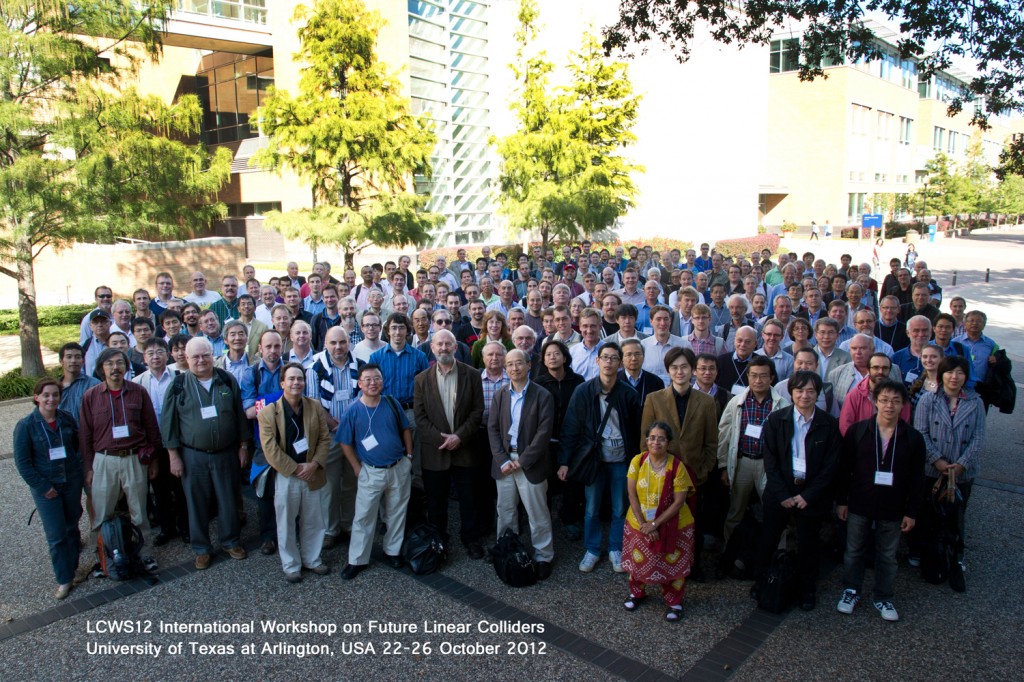
The global ILC and CLIC communities, including Physics and Detectors, met last time in Arlington, US, for the LCWS12 workshop in October 2012. Image: University of Texas Arlington.
The Linear Collider Collaboration (LCC) officially started at the Vancouver Linear Collider Board (LCB) meeting in February 2013, and the new organisation is slowly taking shape. I was appointed Associate Director for the Physics & Detector portion of the new structure. LCC director Lyn Evans told us that he thought the task assigned to this post would be the most difficult one.
So what is the mandate of the Physics & Detectors Associate Director? The mandate given by the International Linear Collider Steering Committee states that initially the Associate Director would focus on building a physics case for a future linear collider, coordinate R&D on advanced detector technologies and develope validated detector concepts for both accelerator technologies (namely CLIC and ILC). Eventually, the Associate Director would coordinate the worldwide effort to develop advanced detectors that are appropriate for either accelerator technology, and would prepare the way for forming collaborations and constructing detectors when a real LC project is approved.
While describing the role of the LCC, it is important to recognise that it is an interim organisation before a real organisation is formed following the approval of a linear collider project. Since it is an interim organisation and the accelerator is not chosen yet, it is important to keep the CLIC and ILC communities together, and also to promote LC-related advanced detector R&D that mar or may not be used in the real linear collider detectors. Currently, the goal of the LCC is to realise the ILC, as the LCC Director clearly stated. However, CLIC efforts need to be promoted in parallel as it is a possible option for a post-LHC machine at CERN, and this is true even if the ILC is realised. In fact, CLIC studies would continue while the ILC moves into construction. After all, no linear collider has been approved at this point.
Now let us take a look at each of the three initial mandates for my task and briefly describe the issues involved. I will be presenting the final idea for the organisational structure at the Hamburg linear collider workshop in May, and the main purpose of this corner is to solicit input from the LC community.
1. Physics case
As the LHC keeps on producing impressing physics output, the physics case for an LC needs to be continuously updated. There is also a clear hope that further LHC running at full energy might open the doors to results beyond the Standard Model, providing significant additional opportunities within the energy range of linear colliders. The physics capabilities of the ILC and those of the CLIC option with a centre-of-mass energy below 1 TeV are very similar, and both communities can and should join their forces together for this goal. There have been many collaborative efforts up to now, both in software tool developments and physics analysis. We need, however, a more formal structure. It will contain theorists and experimentalists, and will be similar to the physics common task group that operated under the research directorate, but there will be clear connection to both the CLIC and ILC analysis groups.
2. Detector R&D
As we move from conceptual to engineering design of the LC detectors, unfinished necessary detector R&D should be completed. Here again, there is a large area of efforts common to both CLIC and ILC, and they have to be coordinated in a more formal and visible way. In addition, the detector R&D for a linear collider has been raising the standards of the high-energy physics detector technologies in general and we should make sure that it will continue to do so. In coordinating such efforts, we should make sure that voices of detector R&D groups, including small groups, are heard effectively by the management. There will be a group of people similar to the former physics and experiment board directly under the Associate Director that will include representation of the R&D efforts. The challenge here is to come up with an arrangement where small but important groups are not ignored while keeping the number of representatives at a reasonable level.
3. Concept groups
Currently, there are two detector concept groups, ILD and SiD, for the ILC, and the CLIC physics and detector group for CLIC. Their design status has not reached a construction-ready level, and this is particularly relevant for the ILC detectors for which much engineering study remains to be done. New individuals and groups are of course very much encouraged to join any of the groups mentioned above. What if, however, a new group appears and expresses its intent to form a new concept group? Such initiative should not be rejected while a new group will clearly be in a disadvantaged position due to the late start. Here, a concrete framework to accommodate such group should be put in place.
Above are the three of key issues for the new LCC Physics & Detector organisation. The physics and detector community is diverse and usually works best when the elements in it act with self-determination, and thus the implementation of the above issues should be as bottom-up and flexible as possible where decisions have to be made by people directly involved. Impositions from above have to be kept to minimum, and we should start with minimum framework as needed to facilitate the activities. If you have any comments or suggestions on these issues, please send me an email.


Recent Comments